Aspley Guise and Woburn Sands Golf Club
The National Archives holds some brief Company Registration records on the formation of this Club under ref. BT31/32160/130137. These open on 23rd September 1913, with a Memorandum of Association. Stanley Harris, of Aspley Guise, was listed as the Chair, with William Needham (a merchant of Haydon House, Woburn Sands), James Croxton Walker (a farmer of The Holt, Aspley Guise) Charles Sinfield (contractor of Aspley Guise), Alfred William Pettit (Croyland, Aspley Heath) John Charles Tarver (Brookside, Woburn Sands) and Francis Crosbie Roles (Malting Close, Aspley Guise) as the other founding members. There is a list of 47 shareholders, along with their addresses and occupations.
I am indebted to Karen Evans, current General Manager of Aspley Guise & Woburn Sands Golf Club, for allowing me to republish the club history below, which was compiled by Des Cole (Club Captain 1980 & Club President 1990-92) in 1999.Michael Evans, (Club Captain 1951) and Geoff White (Member and President of Aspley Guise Cricket Club) assisted with historical information and Mal Nally (Member) edited the work.
I have used some of the illustrations from his original book, plus some postcards from my own collection and some other artefacts.
Two Nines Make Eighteen – The story of Aspley Guise and Woburn Sands Golf Club
1899 – 1904 & 1914 – 1999
In the Beginning….
The records of the Club prior to 1949 can no longer be found. Fortunately, there are some members still living whose fathers were members before the Second World War and they have kindly provided valuable information from that period of the Club’s history.
In May 1899 some enthusiastic exponents of golf decided to form a club in Aspley Guise and District. Suitable and convenient land was obtained at Major Downes’s “Berrylane Farm” which was situated on Salford Road, close to and on the Salford side of the Aspley Guise railway crossing. The subscriptions were fixed at £1-1-0 for gentlemen and 10/6d for ladies. Mr Harry Mordaunt who had been Treasurer of the Cricket Club since 1892 became the Secretary. Within a month the Club had become known and a good number of members enrolled. The weather had been poor, but it was reported that a few ardent devotees of the game had been seen indulging.
The family of Col. Browell, living at Guise House, were members and Mr White (Senior) who was aged 12 at the time, earned money by cleaning muddy boots. His son Geoff is a current member of the Club, and is also President of the Cricket Club.
The golf course included the golf pond, which was surrounded by aspen trees and had been part of an old brick works.
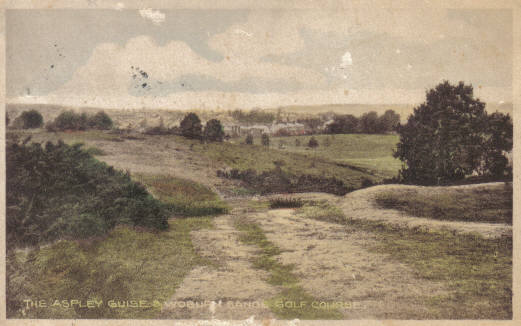
With the removal from the district of several prominent players, including Col. Browell who went to Berkshire, the Club closed in October 1904 and was wound up. There was a considerable balance in hand, and this together with the sum realised from the sale of the Club’s property was distributed among various institutions in Aspley Guise and Woburn Sands, including the Social Club and the Cricket Club. The Social Club received 100 shillings (£5.00) and is recorded in their minutes.
The earliest reference to the present Golf Club is reported in the local paper of the time, “The Woburn and District Reporter”’. In its issue of May 18th 1912, it quotes:
“Some 12 months ago on the initiative of the Reverend Malby and Mr Wilkinson a plan was prepared for a 9 hole golf course on land from the Cricket Ground down to Rodwell Pit, leaving out building land next to the road. The scheme fell through at the time. With the demise of the Bletchley League the players there will now have to travel to Bedford or elsewhere unless a course is found nearby. If now everyone interested could gather together there could be a good opportunity to resuscitate the original plan”.
Note: Rodwell Pit is the wooded area to the rear of the ladies 18th tee. Building land next to the road could be Weathercock Lane.
In the same paper, issue dated March 1st 1913, there appears the following quote:
”A meeting of interested parties met at “The Holt” to discuss the golf links”.
Note: In 1913 “The Holt” – now Moore Place Hotel – was a private house.
It is obvious from subsequent issues that those concerned were very keen to get started and were not subject to the restrictions of today; the issue dated March 15th of the same newspaper, just three weeks later quotes:
“The golf links seems to be delayed due to a setback owing to the obstinacy of one individual who owns and occupies part of the land of the proposed links and wants compensation. A reasonable amount has been offered but like Oliver Twist he wants more”.
W. B. Stonebridge, an Estate Agent, who was the instigator in the movement, formed a strong committee, many of whom were Cricket Club members and officials. They included Mr S Harris, the Cricket Club Chairman and Treasurer, who was Chairman of the Golf Committee, C J Walker, C Sinfield, A W Foll, E Bathurst, B Creasey, H J Hicken, W Needham, J C Tarver, W W Pettit, E Fisher, S G Wilkinson and the Reverend Malby. Mr Stonebridge became Secretary. About 51 acres across the Common and through the farms of Mr G Tansley and Mr Bailey would make the course, with the entrance near the Cricket Ground, where a pavilion would be erected. Membership would be limited to 150 and a Limited Liability Company would be formed with debentures of £5.0s 0d each bearing 4% interest.
A further meeting of interested parties was held at the end of March to discuss the report of inspection made by Mr Alex Herd, the Open Golf Champion of 1902. In his report Mr Herd wrote:
“By all means good, it is one of the most perfect spots in the Kingdom, the land is right, and if you can get the money, this will make an excellent 9 hole golf course”.
Following this report the Secretary of the Committee, Mr Stonebridge, arranged a public meeting with Mr Stanley Harris as Chairman.
It was reported that Sir Henry Hoare, owner of the land, was prepared to lease the land at a very low rent once all the present tenants had been compensated. It was hoped that Sir Henry Hoare would become the Club’s first President.
Within a few weeks sufficient funds were available for work to commence on the course. After five months, work was reported to be on schedule and Mr Stonebridge indicated that the course would be ready for play by late Spring of the following year – 1914.
As the course took shape, there was considerable discussion in the district regarding its value to the community. The local paper reported in its issue of August 23rd 1913:
“Will it benefit the district? This has been repeatedly asked and answered by many with shoulder shrugs. Looking at it squarely there cannot be any room for doubt, the one thing that the neighbourhood needs is a boom in something, and once the beauties and attractions of this course are known, the result will be obvious”.
The entrance fees were one and a half guineas and the subscriptions were 2 guineas for ladies and 3 guineas for men. Visitors were charged 1/6d for 18 holes. It was said to be the finest 9 hole course in the County. Sunday golf caused trouble among the supporters and some who promised to put money in withdrew at the critical time because of this. The links were available on Sundays but players had to make their own arrangements for games. The Sunday play was severely condemned by Mr F Bodley, of the Wolverton Wesleyan Circuit who stated that “if caddies could not see where the ball dropped and could not find it, they often heard language they would never hear in the house”. There was a general feeling among members that an exhilarating game of golf in the fresh air, even on Sundays, could do no harm and may even benefit the players.
It was also reported in the same edition of that paper that when the course was open for play Mr Creasey would become the Honorary Secretary; in the meantime Mr Stonebridge would continue his duties until the course construction was completed. Mr G Wilkinson was elected Captain, and was at that time Captain of the Cricket Club, a feat which to date has not been repeated.
Within a few weeks of the announcement of the new Secretary, it was recorded that Mr Linney, the foreman in charge of the construction of the golf course was being replaced by a Mr Charles Willmott of the Cambridge University Golf Club. Thus began the association of Charles Willmott and Aspley Guise Golf Club which lasted until his death in 1986 aged almost 100 years.
With Charles in charge the development of the course went ahead with great speed. Even with primitive tools, compared with today’s mechanisation, it was arranged for a Grand Opening Day on May 7th 1914. This date being less than 12 months since the start of construction.
The length of the course was 2610 yards; the same nine holes today measure 2920 yards. The comparative length in yards of each hole are as follows, remembering that the nine holes in 1914 are now the second nine:
| 1st | 2nd | 3rd | 4th | 5th | 6th | 7th | 8th | 9th | |
|---|---|---|---|---|---|---|---|---|---|
| 1914 | 140 | 305 | 374 | 100 | 440 | 157 | 315 | 317 | 462 |
| 1999 | 166 | 337 | 388 | 136 | 491 | 188 | 347 | 373 | 494 |
On the opening day a special train was made available from London and more than 450 spectators were present to watch an exhibition match by Ted Ray, Alex Herd, Tom Ball and B Batley. The lowest score of the day was returned by Tom Ball who had a 68 for 18 holes. The event was reported at great length by all the local papers and some weekly magazines.
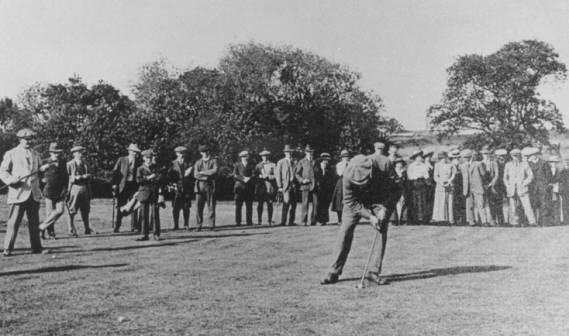
An article in Golf Illustrated reported that the new nine holes were now available for play and their reporter said that the course was an “oasis of tranquillity and beauty after the dirty grimy streets and houses along the walk from Woburn Sands railway station”.
A report in one local paper read that two ladies were overheard in the refreshment tent discussing various subjects when the conversation turned to golf. One was quite at home on the subject but the other lady, confessing that she was at some disadvantage, remarked “Oh, I should love to play, but I’m afraid I shouldn’t know where to hold my Caddie”.
With the declaration of the First World War in August 1914, it was considered by many people in the area that the new Golf Club would fail but contrary to popular belief, just the opposite occurred. By the end of 1914 many top clubs were using the course, including both Oxford and Cambridge Universities, who played several times. Probably this was due to the proximity to the railway stations, which in those days linked the two cities.
During the war the local and national newspapers were full of reports from the front line and any talk of sporting activities at home were considered counterproductive to the war effort. The Club remained open during this period but like many other sports clubs suffered considerable financial problems, a situation which existed into the 1920’s. Indeed, had it not been for one or two generous benefactors, the Club could have easily closed down during that time. Whilst several ladies were members from the beginning, it was not until 1922 that a ladies section was formed, and records show that Mrs B A Image was the first Lady Captain in 1924.
In 1920 the Social Club received a donation of £70.00. At the time there was a demand for a bathing pool and after some research the location selected was the Mill stream, which is the stream running from the right of the 15th green, through the woods to the back of the 13th green. The owner, Sir Henry Hoare agreed to a concrete basin being built but there were strong objections made from the Golf Club on the grounds that the site was too close to the ladies tee and that they would be able to hear and see men bathing. Sir Henry withdrew his permission and the project was cancelled.
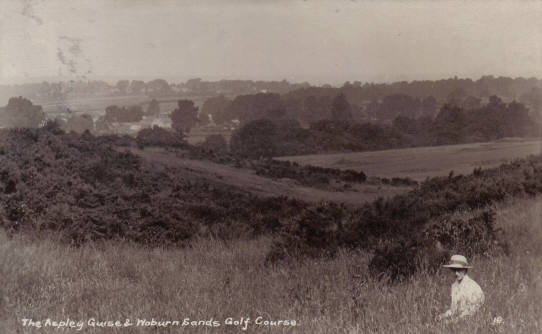
Whilst there is little evidence recorded, this was obviously a period of consolidation and for most of those years Charles Willmott remained, not only Club Professional, but was also in total charge of the course. This situation remained until 1931 when the Board of Directors appointed Willy King as Greenkeeper, a position he retained until 1964. His wife was Steward for the same length of time and after her retirement in 1964 she often acted as stand-in as Stewards came and went over the following six years.
The Club’s first “Red Letter Day” was perhaps June 20th 1938 when the following appeared in the District Gazette:
“Memorable day for local golfers, Club celebrates 25th Anniversary. Presentation to Professional – been with Club since inception, also unveiling of Captains’ board given by Mr A G Cook. Wednesday was a great day for them and apart from the celebration of the 25th anniversary it was also the occasion of a presentation (for which had been subscribed the magnificent sum of over £150) to the Club’s Professional, Charles Willmott.
Welcome visitors were the well-known professionals Sandy Herd and James Ockenden, the last named substituting for Ted Ray, prevented from attending by illness. Sandy Herd laid out this beautiful nine hole golf course and opened it 25 years ago. During the day the two professionals played a four ball match over 36 holes with Mr A G Cook and Charles Willmott.
The first round in the morning was won by the professionals. After the match, Sandy Herd unveiled the Captains’ board. The board gives the names of all the Club’s Captains, many of whom were present. It had been felt for some time that there should be a Captains’ board as most other clubs had these. This very pleasant board had been made by Director Sinfield and bore the names of the Captains of the Club since its inception.
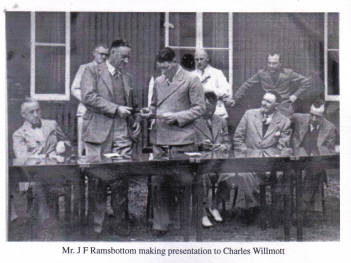
A large company gathered in the evening for the presentation to Charles Willmott. Mr J F Ramsbotham who presided, said he had a lot for which to thank Charles Willmott who initiated him into golf about 15 years ago. Willmott had been a very good friend to the Club and has always met everyone with a smile and a cheery word. That he had always done his best to look after the Club’s interest was evidenced by the magnificent response to the appeal for his testimonial, which had raised £150 7s 6d. They had spent £26 2s 0d on a gold watch and handed Willmott a cheque for £124 5s 6d.
Mr Ramsbotham announced at the meeting that Charles Willmott had been voted an Honorary Life Member of the Club.
When Charles Willmott rose to reply he was visibly affected and could not speak for a minute or so. He thanked them for the cheque and the watch and said it was a source of great satisfaction to know that his services had been appreciated, and he hoped that he would serve the Club well in the future”.
As an afterthought, the paper did mention that in the afternoon the second round was won by Mr Cook and Charles Willmott, 2 and 1, with a better score of 71 against 74. The record for the course was 57 and bogey was 72. In those days bogey was what we know as par today.
The Second World War created major problems for the Club. Many of the leading members, plus Charles Willmott were called up into war service. Major competitions and inter-club matches were all cancelled. With reduced membership and increased costs, and in many cases, basic materials were almost impossible to obtain, the Club, and course, deteriorated to such an extent that for several years it was at the point of closing. During these years the Club became more of a social club than a golf club due to the age of the Club members.
In the years immediately after the war Club finances were at an all-time low; personal loans from one or two members kept it from becoming bankrupt. In 1947 the owner of the land (second 9 holes), Sir Henry Hoare died, and the 62 acres were offered to the Club for £5,000. Up to that stage the Club was paying an annual rent of £2 17s 4d (£2.87). With personal and bank loans the Club purchased the land.
The purchase of the land, together with the resumption of inter-club matches and internal competitions revitalised the Club, but while the membership was around 250 in total, the average number of men playing in competitions was only 45.
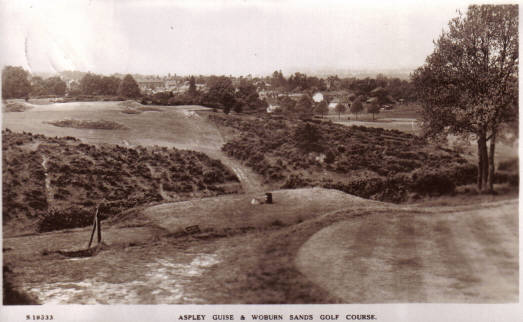
A major change to the Club took place in 1951. The Captain, Michael Evans and two members, Mr Woolley and Mr Williams (both of whom were solicitors) arranged to alter the management and ownership of the Club. The old Directors of the Club were persuaded to refer their shares in favour of the members and Michael Evans was the first true Captain of Aspley Guise & Woburn Sands Golf Club – a private members’ club.
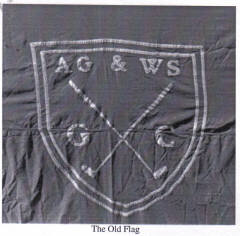
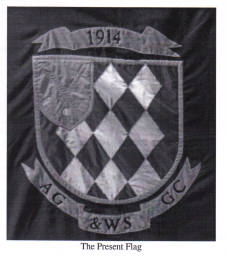
In 1953 a competition was held for all Club members to design a club badge. Mr L Beasley’s design was considered the best and a flag was produced and presented to the Club by one of the (then) oldest members, Mr Joe Bushell who hoisted the flag on September 27th 1953. The present flag was designed by Doug Lancaster, who was a senior member of the Club and a well-known local artist. The design is based on the heraldic arms of ASPLEY and GUISE, both of which were prominent families of the area and gave the name to the village in the Middle Ages. [The name actually derives from “Aspelia De Guise” meaning the aspen clearing of the De Guise family.]
Perhaps the most unsettling event of the decade took place in 1956 with the retirement of Charles Willmott who had watched over the affairs of the Club, and all events for more than 40 years. He not only built the course, but maintained it for all those years as well as being Club Professional from the beginning and a Life Member of the Club since 1938. To replace him was almost impossible; six different professionals during the next ten years provides a good illustration.
Following a fire part to the old clubhouse, a new clubhouse was built and opened in 1964. From 1967 all club activities have been recorded in the Captain’s yearbook which was presented to the Club by Victor Hill.
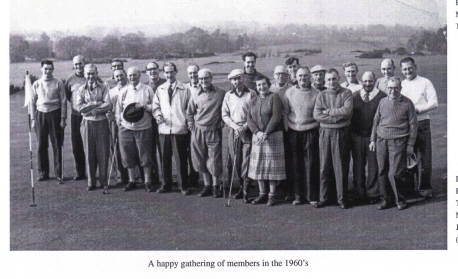
The highlight of the 1960’s was the Club’s Golden Jubilee in 1964. This special year was concluded with a dinner and presentation at the Wilton Hall, Bletchley. The guest speaker was the then Chief Medical Officer, Sir George Godber. His wife presented cups to the year’s competition winners. Included in the prizewinners was a certain Vicky Grace who was the Junior Club Champion; thirty five years later she holds the position of Assistant Club Secretary. The Club President at the time was Jack Cook who, with his wife, was presented with a gold sovereign to mark their long service to the Club.
Whilst little is recorded, the Club improved year by year and by 1969 negotiations started to purchase land for an additional nine holes. The negotiations came to fruition in 1974 with the opening of the new nine holes which were designed by Robert Sandow. After 18 months many faults in the construction came to light but unfortunately Robert Sandow Ltd were in liquidation and at that time the Club could not obtain recompense. It was then that the Frost brothers – Adrian and Brian – of Frost’s Garden Centre, who were members of the Club, came to the rescue. Thanks to their experience and generosity, greens were re-laid, fairways drained, bunkers moved, deleted, rebuilt and added, and tee areas were increased.
The 18 hole course was becoming very popular with visitors and golf societies which helped to improve the finances of the club, which in turn enabled the committee to invest in modern equipment to facilitate course maintenance. In the late 70’s the dining room annexe was enlarged thus allowing societies to enjoy private dining facilities. Some ten years later the clubhouse was redesigned; the pro-shop was demolished and a house was built on the site to accommodate the Steward. The Steward’s flat and garden were converted to provide additional changing facilities, increasing the ladies’ lounge and providing a new pro-shop.
Additional land was purchased in 1990 from the Barnwell family with a view to establishing new or additional holes to improve the playing facilities and in recent times the watering system and bunkers were completely modified.
THE CLUB COMPETITIONS
Most of the Club competitions have been played for many years, some with interesting beginnings. They relate to past personalities and are our only remaining links with the early life of the Club. Most of the original boards were lost during the building of the present clubhouse, and early winners of some competitions were not transferred to the current boards.
THE SINFIELD TROPHY
This was one of the first competitions to be played for in the Club, probably during the First World War. It was presented by Dick Sinfield (Senior); he was a founder member of the Club and owner of a very successful building company which was carried on by his son. Both father and son were benefactors of the Club.
THE ZAIR CUP
Mr Zair was a joining member of the Club during the first year of the Club’s existence. He was by profession, a schoolmaster. Whilst at Aspley Guise he was Headmaster of the boarding school on Aspley Heath. There are no records of his handicap but his number of wins in various competitions indicate that it was lower than average. A photograph in the clubhouse shows him playing in a heavy jacket which would add a few strokes to the handicaps of current members. He also remains the longest serving Captain of the Club – a total of five years.
THE TINGEY & SPRAGUE CUP
This trophy was first played for in 1950 during the Christmas period. It may have replaced the Bogey cups which in the same year were moved to the summer months. Mr Tingey and Mr Sprague were Directors of John Bull, Jewellers, in Bedford and they also owned a small jewellery shop in Woburn Sands. Neither played golf but one of their employees, Mr O’Keeley, was a member of the Club. He presented the cups on their behalf, no doubt in recognition of their business arrangement with the Club in supplying trophies, etc.
JOE WATSON CUPS
Joe Watson was a member of the Club from the early 1930’s. He was a member of the old Board of Directors prior to 1951 and was Secretary of the current Members Club for nine years – 1959-1968. The cups were presented to the Club by his widow and first played for in 1969.
THE BOGEY CUPS
This competition has been held since the early 1920’s and it is recorded in the Minutes that the cups were played for during the Christmas period – 24th, 25th and 26th December (short holidays in those days). It was a Bogey competition played as a stableford: it should be explained that until the. late 1940’s bogey was what is now called par. We have to thank – or otherwise – the Americans for the current term of one over par as bogey. These cups were presented to the Club by Mr Leigh Bennett, who was Secretary prior to the Second World War.
THE POSTON TROPHY
The trophy was presented to the Club by Mr & Mrs Poston (Ted and Lily) who were Jewellers in London but lived in Woburn Sands during the Second World War. All the Club’s prizes and trophies were purchased from them during the war and on their return to London in 1950 they left the Club the Poston Cup.
THE RAYMOND MARTYN CHALLENGE CUP
Although the facts cannot be confirmed it is believed that Raymond Martyn was a very keen junior member of the Club who died at an early age. The trophy was presented to the Club in his memory by his parents during the 1920’s.
THE WILLMOTT TROPHY
The trophy first played for in 1977 reminds us of our celebrated member Charles Willmott. At his request it can only be entered for by those members with a handicap of 18 or less. He firmly believed that an 18 handicap was achievable by all dedicated golfers.
THE GRACE TROPHY
Hector Grace, who died in 1991, is remembered by many members as a quiet, caring man who actively encouraged families to join the Club and take part in all its activities. The Grace Trophy was part of this encouragement for families to play together. The competition is restricted to blood relations and husbands and wives. Until his death Hector always presented his cup to the winners. This competition was first played for in 1970, the year that Hector was Captain.
THE JACK GARNER TROPHY
For many years the Club has included in its competition programme a four ball better ball trophy. Just before the Second World War a gentleman farmer, Mr Garner, joined the Club. He was a regular member of the team for matches played every weekend and was on the course most weekdays. He was a joy to play with and was usually on the winning side. On his death the committee of the day renamed the winter four ball competition “The Jack Garner”.
THE EUNICE HUTTON TROPHY
Eunice was the wife of a prominent builder in Woburn Sands and for many years she, and Margery Griggs managed the Ladies section of the Club. To mark her retirement in 1971 she presented a cup for senior ladies – a singles matchplay knockout competition.
CHARACTERS FROM THE PAST
In every club and society one comes across various characters and while there are no recorded memories from the early years of the Club, since the 1960’s there have been several members who will always be remembered for their individuality.
A certain Bill Prout who would insist in playing in plimsolls (canvas deck shoes) in dry weather. Verbal and written warnings were given, but to no avail, because as soon as the dry weather returned it was off with the golf shoes and on went the plimsolls.
Another member who took great care of his feet was the local chiropodist, Alfred Myatt. At the first sign of dampness he put on his calf-length Wellington boots which were equipped with golf studs.
When the Ml motorway was built a local undertaker, Percy Mason from Newport Pagnell needed to be on duty 24 hours a day. A bell was installed on the course to inform Percy that his services were required on the motorway. This was of course, many years before mobile telephones came into use.
Dr Desmond Morphy was a long-standing and much respected member who found the secret of good golf, or at least that is what he claimed after every round. In his later years he would, after 17 holes suggest that the final hole was played from ‘his’ forward tee, which was alongside the ladies’ tee, then just short of the bridle-way. Even today many people suggest playing the last hole from ‘Doc. Morphy’s tee’.
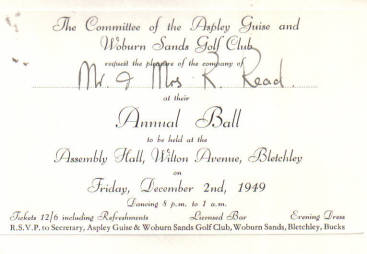
The ladies also have had their celebrities; two of these being the Robinson sisters -Irene and Dorothy – both of whom were school teachers. Irene was of ample proportions whilst Dorothy (Do Do) might be considered somewhat anorexic. Irene enjoyed a few holes of golf on Sunday afternoons, but both were regulars at the bar. Irene would spend many hours with her chair facing the fruit machine, daring anyone else to use it. Dorothy enjoyed her gin and tonic, and it was said that on a ‘good night’ she could put away a whole bottle of gin with just one bottle of tonic. Irene was the driver and her main task was to transport Jack Garner to and from his home to the Club.
As indicated earlier Jack Garner joined the Club during the 1930’s and was what was called a gentleman farmer – more of a gentleman than a farmer. He played most days during the week as well as weekends and was a joy to play with. After the game he would consume half pints of lager indefinitely. No matter what state of sobriety he was in at the time he always stood to welcome any lady member who entered the bar. A one in a million gentleman was Jack Garner.
At the other end of the bar could be found another gentleman – John Harrison. A single figure golfer, a concert pianist and drinker extraordinaire. It was quite normal for him to have half a dozen pints of beer before going out to play a round and then return to the bar for more until a taxi would collect him and take him to his home which was 200 yards away. He was employed by the Foreign Office and one of his postings was to the West Indies. He was flown out on a Friday but was back in the clubhouse by the following Tuesday. Apparently the free gin and tonics on the journey out were rather too much for him and he was reassigned back to the U.K.
Another much loved personality was Maud Allen, who still lives in the bungalow at the side of the men’s 16th tee. Maud (nee King) joined the Club in 1922 and after a few lessons from Charles Willmott entered her first competition. It was a ‘flag’ competition and playing with a handicap of 36 she completed 18 holes and still had 18 shots left. The result was that her handicap was reduced to 18 (Silver Division) and she remained in that division up to the time she finished playing golf, when she was in her 80’s. Her first husband was Joe Bushell, a long-time President of the Club, and when he died she donated the Bushell Cup to be played for by all ladies on Ladies’ Day. In later life she married Joe Allen and with him won the Grace Trophy.
No records of the Club would be complete without mentioning Charles Willmott who was recruited by the Club in 1913. Initially he was engaged to complete the design and construction of the course, but following the opening in 1914, he continued to have responsibility for the maintenance of the course as well as being the Club Professional. In 1918, like so many others, he was drafted into the army, during which time he was awarded the Military Medal for bravery and when the war was over he returned to continue his service to the Club. Charles was a founder member of the Professional Golfers’ Association when it was formed in 1920 and he became a contributor to Golf Illustrated, a connection that was to last until his retirement in 1956.
In 1987 a Pro-Am competition was held at the Club to celebrate Charles’s 100th year and the day’s proceedings concluded with the unveiling, by Henry Cotton, of a bust specially commissioned to honour Charles’s immense contribution to the Club. The bust which is displayed in the clubhouse stands as a fitting memorial to this very fine gentleman and most loyal servant of the Club.
THE WILLMOTTS
Like in many Clubs, the number of older members has increased during the last five decades. During the 1970’s several of the Club members started to play together during the week rather than at weekends to avoid course congestion and one or two matches were arranged with other Clubs. With early retirement being offered many more older members opted for five-day membership and in 1980 the then Club Secretary. L Barker, who was also of retirement age, approached the Club and Charles Willmott with a view to forming a Senior section. Both the Club and Mr Willmott agreed to the proposal and the Senior section was established. The name chosen for the group was “The Willmotts” and they have their own Captain, Secretary and Treasurer.
At the present time there are more than 80 members of “The Willmotts” playing their own competitions and inter-club matches.
THE LADIES
The ladies section was formed on 9th July 1924 with a total of ten ladies and continued to be small in numbers up to and including the Second World War. However, from these few numbers the section provided three County players and the County Captain. During the 1920’s and 30’s Mrs J Cook was Captain, and her sister together with Mrs Bushell, then Miss King, were regular members of the County team.
From October 1939 until May 1946 the Committee and Officers were held in abeyance. No inter-Club or County games were played during the war. There were no recorded minutes of the period but it is understood from other sources that the ladies continued to be active in the Club during those years.
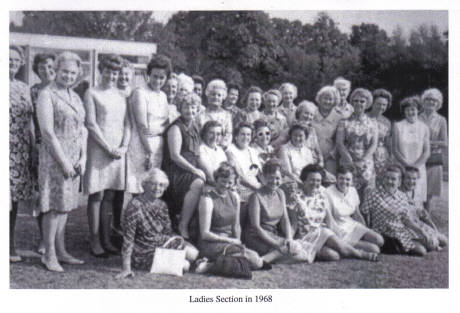
The competition entry fees during the 1940’s was one shilling (5p) and at the AGM of 1947 it was reported that a balance of £10. 0s 0d was held in the Bank on deposit. Committee meetings were held about every three months. At the AGM of 1948 the first Lady President was elected – Mrs Allen – who held the position for 53 years. During her time in office her husband received a knighthood.
The number of ladies playing golf was still quite low, and it is recorded in the minutes, that “unless at least eight members entered the monthly medal, a ball would be presented to the winner, and not a medal spoon due to the constant cost increase of the silver spoons”.
From 1960 the membership of the section increased on an annual basis to 20% of the total membership which explains why it takes much longer for ladies to obtain membership than their male counterparts.
CLUB ADMINISTRATION
There are 430 Full and 130 Five Day members, including ladies, with a further 40 Juniors and Colts making a grand total of 600 members at the present time
The elected Committee consists of President, Vice-president (the immediate past Captain), Captain, Vice-Captain and 10 members; the average period of service on Committee is 3 years.
Since 1990 ladies have been able to seek election for, not more than 2 Committee vacancies. In addition there are 5 sub-committees – Finance, House, Handicaps & Competitions, Development and Greens. The officers, sub-committee Chairmen and Secretary / Manager make up the Management Committee, which is primarily a discussion forum on major items of Club business and which makes recommendations for consideration by the full Committee.
The permanent staff comprises the Secretary / Manager, Assistant Secretary, Head Greenkeeper, plus a staff of 4. The Chef and Senior Bar Man and a cleaner / handy-man all report to the Secretary / Manager. The Club Professional is self employed but is paid a retainer.
THE CLUB AND COUNTY
The first County Golf Union was formed in 1893 by the Golf Clubs in Hampshire and the Isle of Wight. Today County Golf Unions are the only formal link with the Royal and Ancient via the English Golf Union. Each Golf Club has a representative on the County Union ivhidi has a delegate on the English Golf Union (EGU).
The Bedfordshire Union was formed in 1923 at the Swan Hotel in Bedford. Aspley Guise and Woburn Sands was not present at the inaugural meeting but joined in the following year. The Clubs involved were BEDFORD (now Bedfordshire), MID BEDS (now Beds & County), SOUTH BEDS, DUNSTABLE and ASPLEY GUISE & WOBURN SANDS. An annual subscription of £2. 2s. 0d. (£2.10) per Club was agreed.
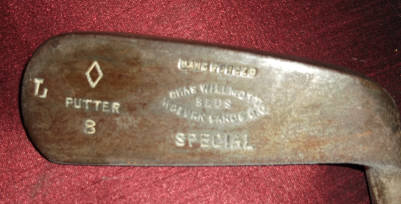
Bedfordshire is small as a golfing county with only 7 truly private members’ clubs registered. There are 15 others which are either municipal, pay and play or proprietor owned.
Since neither of the Bedford courses were in playing condition the first County competition was held at Dunstable on 5th June 1924. 88 entries were received and on the day the winning scratch score was 158 over 36 holes.
Seven years later a certain Henry Longhurst won the County Championship. Henry was a Bedfordian, his family owning a furniture store in Bedford. He is best remembered for his golf commentaries on the BBC. While Aspley Guise & Woburn Sands was always represented in the County Championships it was not until 1950 that we produced winners, in the scratch foursomes – Michael Evans and Frank Canvin.
Vernon Stevens in 1961 became the first member of Aspley Guise & Woburn Sands Golf Club to be elected County President and in 1964 he became County Captain (non-playing). He continued to take a very active part in County golf until the time of his death in May 1985. The first President was W E Browning from South Beds.
In January 1978 Dick Sinfield was elected County President but his death in December of the same year was a great loss not only to Bedfordshire but particularly to Aspley Guise & Woburn Sands; both he and his father before had been generous benefactors of the Club.
The Presidents of the County Golf Union retain the position for a period of two years, and in general, each club takes it in turn to provide nominations for the office.
In 1971 it was decided to form a County Captains’ Society. As a result positive links with Clubs in the County are maintained and it provides helpful contact for current Club Captains who through their membership of the Society are able to compare notes. It also enables Captains to meet their counterparts from other Clubs with whom they do not have an annual fixture.
For those past Captains who find it difficult to attend any County Captain’s events we have, at Aspley, a gathering of our own past Captains once a year. In the 10 years since this was started an attendance of 75% has been achieved, with Captains from as far back as 1951 being present.
| Club Captains | ||
|---|---|---|
| 1914 S G WILKINSON | 1943 L J COOK | 1972 J LANGLEY |
| 1915 F CROSBIE ROLES | 1944 D W BARNES | 1973 T STEELE |
| 1916 E CREASEY | 1945 DR B MORPHY | 1974 B COPPERWHEAT |
| 1917 R E CAMBELL | 1946 W LEIGH-BENNETT | 1975 R F CRISP |
| 1918 R E CAMBELL | 1947 J D BUSHELL | 1976 L H COWLEY |
| 1919 R E CAMBELL | 1948 K W GRIGGS | 1977 A E FROST |
| 1920 J A ZAIR | 1949 V GOLDSWORTHY | 1978 D A ALDERTON |
| 1921 J A ZAIR | 1950 F W CANVIN | 1979 B T BROWN |
| 1922 J A ZAIR | 1951 M J EVANS | 1980 D R COLE |
| 1923 J A ZAIR | 1952 F D THOROGOOD | 1981 T WHITE |
| 1924 J A ZAIR | 1953 D H WALDRON | 1982 H C JACKSON |
| 1925 S H ROWLAND | 1954 L G BROWN | 1983 A CROOK |
| 1926 S H ROWLAND | 1955 R A FULTON | 1984 T E SIMPSON |
| 1927 S H ROWLAND | 1956 C J WOOLLEY | 1985 D CLARK |
| 1928 E MUIR-DENHAM | 1957 V B A STEVENS | 1986 A REYNOLDS |
| 1929 E MUIR-DENHAM | 1958 J WATSON | 1987 M A BEADLE |
| 1930 H S BAKER | 1959 DR E WITHERIDGE | 1988 J C ASTLEY |
| 1931 H S BAKER | 1960 J IKIN | 1989 T S BALI |
| 1932 E W MARCHANT | 1961 A B HAWKINS | 1990 P W TAYLOR |
| 1933 E W MARCHANT | 1962 A T WILLIAMS | 1991 H J WORSFOLD |
| 1934 F T TAYLOR | 1963 A T WILLIAMS | 1992 R A HALE |
| 1935 F T TAYLOR | 1964 D BARKER | 1993 DR A WADE |
| 1936 A G COOK | 1965 J IKIN | 1994 R J LARBEY |
| 1937 A G COOK | 1966 L C PARRY | 1995 S L LAFFAN |
| 1938 J RAMSBOTHAM | 1967 V R HILL | 1996 P E RUTT |
| 1939 J RAMSBOTHAM | 1968 C DRABBLE | 1997 D HARRIS |
| 1940 A R SINFIELD | 1969 R C SINFIELD | 1998 M J TALBOT |
| 1941 A R SINFIELD | 1970 H T GRACE | 1999 P BRIDGE |
| 1942 L J COOK | 1971 DR B MORPHY | 2000 D W STRADLING |
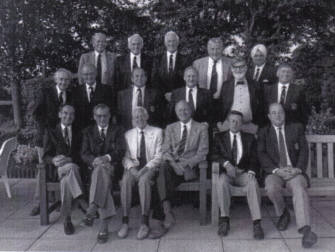
| Lady Captains | ||
|---|---|---|
| 1924 MRS B A IMAGE | 1966 MRS R DELLER | 1985 MRS J HODGKINSON |
| 1925-31 MRS W E TOMPSON | 1967 MRS R G ADAMS | 1986 MRS J M STRADLING |
| 1932-34 MISS K SALMONS | 1968-69 MRS R F G EKE | 1987 MRS M DUDLEY |
| 1935-36 MISS B H HEPARD | 1970 MRS W CARDNO | 1988 MRS B TAYLOR |
| 1937 MRS L J COOK | 1971 MRS O B ARNOLD | 1989 MRS P HARRIS |
| 1938-39 MRS B J FLEMING | 1972 MRS I STEELE | 1990 MRS P J OWEN |
| 1946-47 MRS L J COOK | 1973 MRS J PAKES | 1991 MRS J C WILKIE |
| 1948-50 MRS J BUSHELL | 1974 MRS R MULLEY | 1992 MRS M HIRD |
| 1951-52 MRS GOLDSWORTHY | 1975 MRS B CRISP | 1993 MRS S WHITE |
| 1953-54 MRS TEBBUT | 1976 MRS B T BROWN | 1994 MRS P M BRIDGE |
| 1955-56 MRS F D MORPHY | 1977 MRS J M STRADLING | 1995 MS H WALKINGTON |
| 1957-58 MRS A T WILLIAMS | 1978 MRS J HORNER | 1996 MRS V A ASTLEY |
| 1959 MRS R A FULTON | 1979 MRS B M SINFIELD | 1997 MRS J HINSON |
| 1960 MRS E HERSEE | 1980 MRS J MOREL | 1998 MRS T E HARTLEY |
| 1961-62 MRS A MARCHANT | 1981 MRS A GIBBS | 1999 MRS M HETHERINGTON |
| 1963 MRS R CLARK | 1982 MRS I SIMPSON | 2000 MRS C JONES |
| 1964 MRS D WAYMARK | 1983 MRS I STEELE | |
| 1965 MRS A H KING | 1984 MRS D H WILKS |
| Club Presidents | Lady Presidents |
|---|---|
| 1914-44 J C TARVER | 1924-77 LADY ALLEN |
| 1945-52 J D BUSHELL | 1986-90 MRS M DUDLEY |
| 1953-68 L J COOK | 1978-80 MRS O B ARNOLD |
| 1969-71 V R HILL | 1990-93 MRS P J OWEN |
| 1972-74 R C SINFIELD | 1980-83 MRS J HORNER |
| 1975-77 V B A STEVENS | 1983-86 MRS D H WILKS |
| 1978-80 A L M HORNER | 1993-96 MRS C COLE |
| 1981-83 B COPPERWHEAT | 1996-99 MRS I SIMPSON |
| 1984-86 J H LANGLEY | |
| 1987-89 D CLARK | |
| 1990-92 D R COLE | |
| 1993-95 M WHITEHOUSE | |
| 1996-98 T E SIMPSON | |
| 1999 P W TAYLOR | |
| Club Secretaries | Club Professionals |
| 1913-14 MR STONEBRIDGE | 1914-56 C WILLMOTT |
| 1914- MR CREASEY | 1956-57 W WEST * |
| -1931 MR PAGE | 1957-58 J REYNOLDS * |
| 1932-36 MR F FLEMING | 1958-62 W EVANS * |
| 1936-38 MR LEIGH BENNETT | 1962-63 M WELLONS * |
| 1939- MR E MARCHANT / MR O HART | 1963-64 T MOUNTFORD * |
| -1948 MAJOR SIMPSON | 1964-68 M FIELD |
| -1951 MR L MARLER | 1968-79 L WRIGHT |
| -1956 BRIG. NICHOLLS | 1980-91 G MCCARTHY |
| 1956-58 MR W HILLS | 1991-95 T HILL |
| 1958-69 MR J WATSON | 1996- D MARSDEN |
| 1969-75 MR L BARKER | |
| 1975-80 MR J IKIN | * Also acted as Clubhouse Stewards |
| 1980-86 MRS C BROWN | |
| 1986-91 MR TE SIMPSON | |
| 1991-96 MR M A BEADLE | |
| 1996-99 MR B HUNT | |
| 1999- MR C R BAKER |
Since the foregoing was written in 1999, the clubhouse has again been completely renewed. For all current information about AG&WSGC, please see their website.
Page last updated Dec. 2018.
